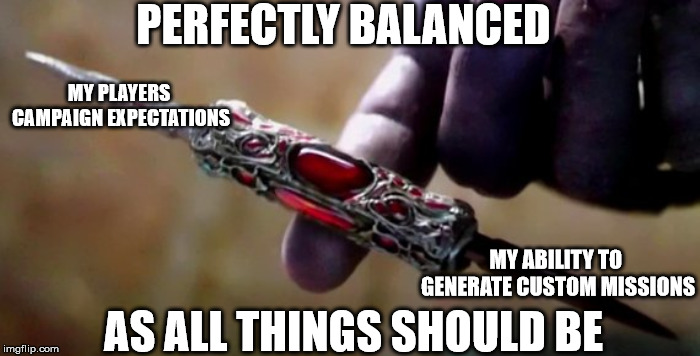
Hi Everyone, after a short break we’re continuing our series (you can find part 1 here ) For this next section I am going to include some tips for maintaining a narrative campaign through the middle stretches.
- Do: Play Sides
At first glance, this point may look odd, but let me re-phrase it slightly: re-balance as needed. One of the hardest parts of running a narrative campaign is trying to balance out, and define, what an appropriate level of competitiveness is. Some players (looking at you Iron Hands) may have armies that are very strong at the moment and can dominate games without even trying. In addition, some players will have more financial resources then others and can deploy more exotic units (back in 6th edition this often took the form of titans in my local meta) As the GM of a narrative campaign part of your job is to maintain a balance among players (as best you can). Now this balance must be approached carefully as some imbalances are due to differences in skill, and players will react negatively if they feel that they are being unfairly punished. To achieve this re-balancing you can take a few steps:
- If you are designing custom missions, consider assigning one side a more difficult task, or to play with a smaller points value. You can frame this as breakthrough elements outracing their support or trying to overrun an entrenched enemy position
- Another option is to give the losing side a bonus for one round, through extra CP or special rules
- Finally, if things have become totally lopsided, you can change the focus of a campaign. One example is in a Chaos vs Imperium campaign I ran the Chaos dominated he first 4 rounds. In order to keep the Imperium side involved I changed the focus of the campaign. In the story the Imperium initiated a retreat from the planet but needed to save a number of artifacts and achieve other tasks before they totally withdrew.

- Do: Provide Variety
Despite what you may have seen online, it is variety that is the spice of life, not salt. In the middling rounds of a narrative campaign, it can be difficult to find ways to keep people involved. This is often compounded by the loss of players (though this usually happens early on as people realize they are over-committed). One of the best ways to fight this is to design missions that feature novel or unusual elements (it can be helpful to review old GW campaign books to get ideas) or to give your players “Choose Your Own Adventure” type elements for them to interact with. These can be as simple as the player being approached by an inquisitor asking them for help finding a certain individual. This can change over the course of the campaign, with the player’s choices affecting the game or just developing a parallel story that allows them to flesh out their own characters in a narrative way.
- Do: Check in with your players

As we discussed in the first article, communication with your players is a vital part of any successful campaign. In addition, this is the tool that will help you follow through on the above two pieces of advice. One of the main ways I communicate with my players is through a group WhatsApp or Messenger thread. I will send out pairings, publish the next round of rules and provide a space for players to give feedback. I will also observe the interactions of the other players to see if they are getting fatigued or losing interest. As someone who constantly worries that his campaigns are dull, reaching out people to figure out what they are enjoying (or are not enjoying) can be both rewarding and invigorating.
Another, perhaps unpleasant, benefit of regular communication is it can tip you off if players are losing interest in the campaign faster then you intended which leads us to our final point.
- Don’t: Lose momentum
One of my weaknesses as a narrative campaign GM is that I want to design convoluted plots for my players to enjoy. I tend to favor longer campaigns but this has also led to another problem: stagnation. It can be frustrating as a GM when you’re only 2 weeks into a campaign and one or more players drop (especially if it is a small group) and this can also frustrate players as it can make campaign games harder to find. In order to fight this tendency, both for people to drop (to the degree it can be mitigated) and player frustration, is to take one of the following approaches:
- Design your campaign to run over a very specific time-frame (something we discussed in pt. 1).
- Find ways for them to count other casual games as part of the campaign narrative.
The first approach incentivizes people to stick with a campaign. It can build trust as the players see it won’t be another group where the story just trails off as people (maybe including the GM) lose interest. It can also benefit the GM by providing a structure for the event so that if you need to end it early you can adjust quickly
The second approach takes a more long-term view. It is an attempt to reward more active campaign participants without penalizing less active ones. I have seen a few cases of campaigns that centered on building up an army lose steam as people who fall behind are quickly out-classed and demoralized. This approach also is helpful if you have players spread out over a large area, as people are not restricted in who they play against.
I hope you all enjoyed my article. As per the previous list of Do’s and Don’ts, I will provide an update on the campaign I mentioned previously, in which I try to live out my own advice and share the results.
And remember, Frontline Gaming sells gaming products at a discount, every day in their webcart!



